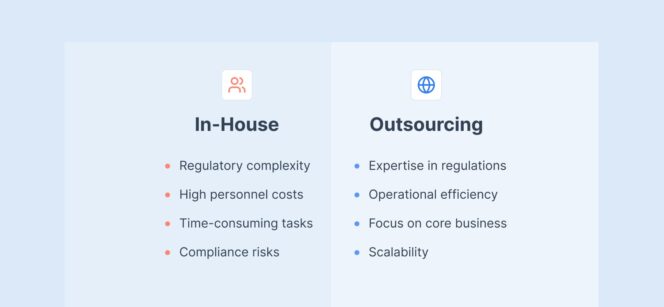In-house vs. external accounting: pros and cons for SMEs?
The financial health of any Swiss business, from a start-up in Zug to a family-owned firm in Geneva, is anchored by its accounting. This essential function is more than just bookkeeping; it is the compass that guides strategic decisions, ensures legal compliance, and provides a clear view of your company’s performance.

For Small and Medium-sized Enterprises (SMEs) in Switzerland, a critical strategic question arises early on: How should this vital function be managed?
The decision typically boils down to two primary models: building an in-house accounting team or outsourcing to an external provider. Each path has distinct advantages and potential drawbacks, and the right choice is rarely obvious. It depends on your company’s specific circumstances, including its size, complexity, budget, and long-term ambitions.
This article provides a balanced and objective comparison of these two models within the unique Swiss business landscape. Our goal is to equip you, the Swiss SME leader, with the clarity needed to choose the accounting structure that best supports your company’s journey to success.
The in-house accounting model
An in-house accounting model involves hiring employees directly onto your company’s payroll to manage your finances. For most SMEs, this doesn’t mean a large department. It typically starts with a single dedicated bookkeeper or a qualified accountant who operates as an integral part of your team, working from your office. As the business grows, this might expand to include additional roles, but the core characteristic remains the same: the accounting function is a direct, internal part of the organisation.
Pros of the in-house model
- Direct Control and Immediate Access: Having an accountant on-site provides unparalleled control. You can walk down the hall to ask a question, receive immediate reports, and get instant financial feedback on strategic ideas. This proximity fosters a deep understanding of the business’s day-to-day operations and financial pulse.
- Deep Company Integration: An in-house accountant is fully immersed in your company culture and operations. They understand the nuances of your business model, your key clients, and your internal processes in a way an external provider might not. This can lead to more tailored financial reporting and insights that are deeply aligned with your specific commercial context.
- Dedicated Focus: Your in-house team’s sole professional focus is your business. They are not juggling multiple clients; their priority is your company’s financial management. This can be particularly valuable during critical periods like fundraising, audits, or major business model changes.
Cons of the in-house model in Switzerland
- High Cost of Qualified Personnel: Switzerland is known for its high standard of living and correspondingly high salaries. Hiring a qualified and experienced accountant is a significant financial commitment. The costs extend beyond the base salary to include mandatory social security contributions (AHV/AVS, IV/AI), pension fund contributions (BVG/LPP), accident insurance, and other benefits, which can add a substantial percentage to the payroll cost.
- The Challenge of Expertise and Compliance: The Swiss regulatory environment is famously complex and constantly evolving. A single in-house accountant, no matter how skilled, may struggle to maintain expert-level knowledge across all necessary domains: the Swiss Code of Obligations (CO), cantonal and federal tax laws, Value Added Tax (Mehrwertsteuer (MWST) / Taxe sur la valeur ajoutée (TVA)), and specific social security regulations. Keeping them trained is an additional, ongoing cost. This exposes the business to the risk of non-compliance if their knowledge base has gaps.
- Scalability Issues and Key Person Dependency: What happens if your sole accountant resigns, takes a long-term leave, or retires? This “key person dependency” creates significant risk, potentially leaving you without financial oversight at a critical time. Furthermore, an in-house model can be difficult to scale. If your business grows rapidly, one person may become overwhelmed, but hiring a second might not be justifiable. Conversely, during a downturn, a full-time salary can become an inflexible burden.
The external accounting model (outsourcing)
The external model involves engaging a specialised firm to manage your accounting function. In Switzerland, this is typically a fiduciary company, known as a Treuhand in German or fiduciaire in French. These firms are licensed professionals who provide a range of financial, tax, and administrative services to other businesses. You delegate your accounting tasks to them, and they operate as your external, expert partner.
Pros of the external model
- Access to a Team of Experts: When you hire a fiduciary firm, you are not just getting a single bookkeeper. You gain access to a collective pool of specialists in various fields—Swiss corporate tax, VAT, payroll, and legal compliance. This collective expertise ensures that every aspect of your finances is handled by a professional with specific, up-to-date knowledge, significantly reducing the risk of costly errors.
- Significant Cost Savings: For most SMEs, outsourcing is considerably more cost-effective than hiring a full-time employee. You pay a predictable fee for the services you need, eliminating the high costs of a Swiss salary, social contributions, benefits, training, and office space. This transforms a large, fixed personnel cost into a manageable, variable operational expense.
- Guaranteed Compliance and Peace of Mind: A core value proposition of a Swiss fiduciary is guaranteeing compliance with the law. Their reputation rests on their ability to keep clients fully compliant with the Swiss Code of Obligations (CO) and all other relevant regulations. This removes a significant administrative and legal burden from the business owner, providing invaluable peace of mind.
- Enhanced Scalability and Flexibility: The external model is inherently scalable. As your business grows, your fiduciary partner can easily allocate more resources to your account. If you need to scale back, the service level can be adjusted accordingly. This flexibility allows your accounting support to grow in lockstep with your business needs without the friction and high costs of hiring or firing.
Cons of the external model
- Less Direct Daily Oversight: By definition, an external provider is not on-site. Communication is managed through emails, phone calls, and scheduled meetings rather than spontaneous conversations. This can sometimes feel less immediate, and some business owners may miss the direct, daily control an in-house employee provides.
- The Need to Find a Trustworthy Partner: Handing over your company’s financial data is a significant act of trust. The success of the outsourcing model depends entirely on the quality, reliability, and integrity of the fiduciary you choose. This necessitates a thorough due diligence process to find a partner who understands your industry and is genuinely committed to your success.
- Potential for Less Cultural Integration: While a good external accountant will strive to understand your business, they will never be as deeply immersed in your internal company culture as a full-time employee. This can sometimes result in a more detached, service-provider relationship compared to the integrated colleague relationship of an in-house model.
Comparative analysis: key factors for your decision
To make an informed choice, it helps to directly compare the two models across the factors that matter most to an SME.
Cost
- In-House: High fixed costs. Includes not just the salary but also 15-20% in additional social charges, pension, insurance, paid leave, training, and overheads like workspace and equipment.
- External: Predictable, variable costs. You pay a retainer or a fee based on the volume of work. This is almost always lower than the all-in cost of a qualified full-time employee, especially for SMEs that do not require 40 hours of accounting work per week.
Expertise & compliance
- In-House: Expertise is limited to the knowledge of one or a few individuals. Staying current with complex Swiss federal and cantonal regulations is a significant challenge and a potential risk.
- External: Access to a broad team of certified specialists. Fiduciary firms are professionally obligated to stay on top of all legal changes, ensuring your business remains compliant. This is their core business.
Scalability
- In-House: Poor scalability. Scaling up requires a lengthy and expensive hiring process. Scaling down is difficult and can involve painful redundancies. The capacity is fixed.
- External: Excellent scalability. Service levels can be adjusted up or down with a simple conversation, allowing your accounting support to fluidly match the pace of your business growth.
Control vs. Flexibility
- In-House: Maximum daily control. Financial data and personnel are on-site, offering immediate access and a sense of direct command over the function.
- External: Maximum strategic flexibility. Frees up capital and management focus to be deployed on core business activities. It trades day-to-day operational control for greater financial and strategic agility.
Conclusion: which model is right for your SME?
Neither the in-house nor the external accounting model is universally superior. The optimal choice is a strategic decision that must be aligned with your SME’s unique profile and priorities within the Swiss context.
The in-house model may be suitable for a larger, more established SME with complex, high-volume daily transactions and a budget sufficient to attract and retain top talent. It suits businesses where the accounting function is deeply intertwined with daily operational strategy and requires constant, immediate input.
The external accounting model, however, is often the more pragmatic, secure, and cost-effective choice for the vast majority of Swiss start-ups and SMEs. It provides access to a level of expertise and regulatory security that is difficult and expensive to replicate internally. By outsourcing, you convert a significant fixed cost into a flexible operating expense, freeing up precious capital and—more importantly—your time and focus to drive the core business forward.
Ultimately, the right decision depends on an honest assessment of your needs. Consider your current growth stage, the complexity of your finances, your budget, and your long-term strategic goals. By weighing the pros and cons outlined here, you can choose the accounting model that will not only keep your books in order but also serve as a powerful foundation for sustainable growth in the Swiss market.



